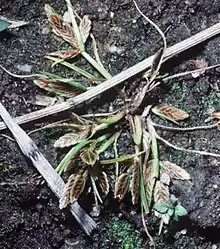Cyperus bipartitus
Cyperus bipartitus, commonly known as slender flatsedge, river cyperus, or the shining flatsedge, is a common species of sedge. The name "slender flatsedge" also applies to Cyperus gracilis.
| Slender flatsedge | |
|---|---|
 | |
| Scientific classification | |
| Kingdom: | Plantae |
| Clade: | Tracheophytes |
| Clade: | Angiosperms |
| Clade: | Monocots |
| Clade: | Commelinids |
| Order: | Poales |
| Family: | Cyperaceae |
| Genus: | Cyperus |
| Species: | C. bipartitus |
| Binomial name | |
| Cyperus bipartitus | |
| Synonyms | |
| |
Distribution and habitat
C. bipartitus is native to the Americas, where it is found widely distributed from north to south in wet environments, such as lakes, sandbars, and ditches from elevations of 30 metres (98 ft) to 1,140 metres (3,740 ft).[1][2]
Description
This is a small annual plant with fibrous roots and thin stems rarely exceeding about 25 centimetres (9.8 in) in height. There may be a one to three thin, short leaves around the base of the plant. The inflorescence is one to two centimeters long and holds several flat spikelets. These may be surrounded by long, leaflike bracts. Each spikelet contains flowers covered by dark reddish brown bracts. The achene fruit is a black disc about a millimeter wide.[3][4]
References
- "Cyperus bipartitus Torrey slender flatsedge". Calflora. Retrieved 12 January 2014.
- Jepson Manual Treatment
- USDA Plants Profile
- Flora of North America